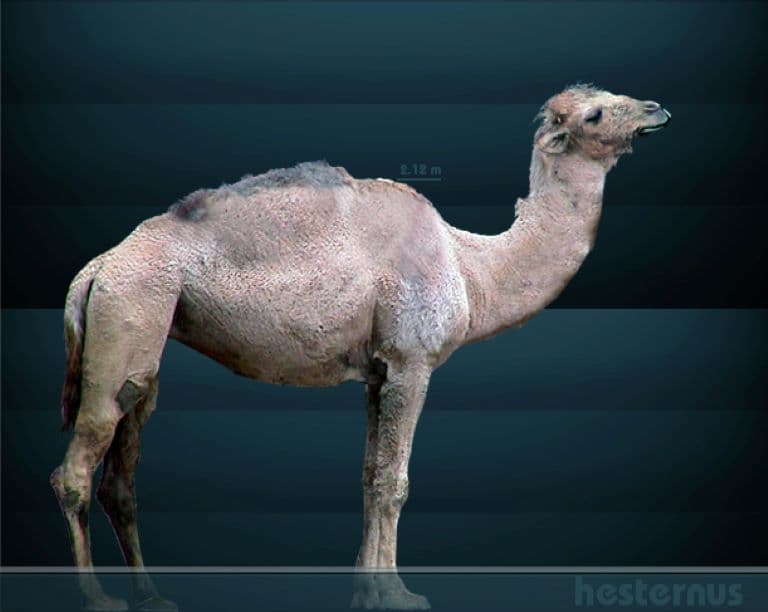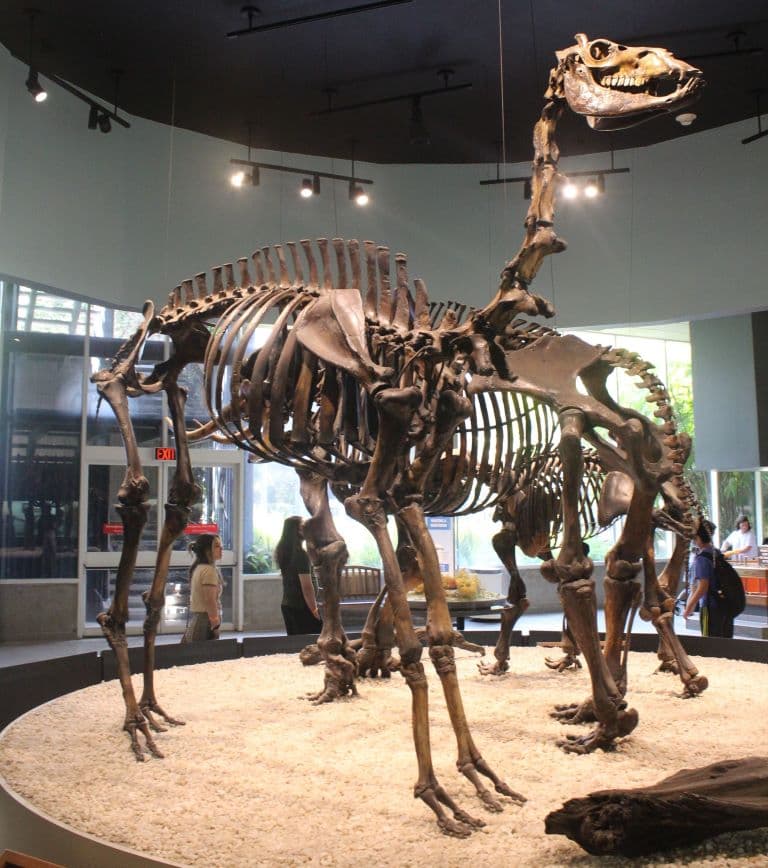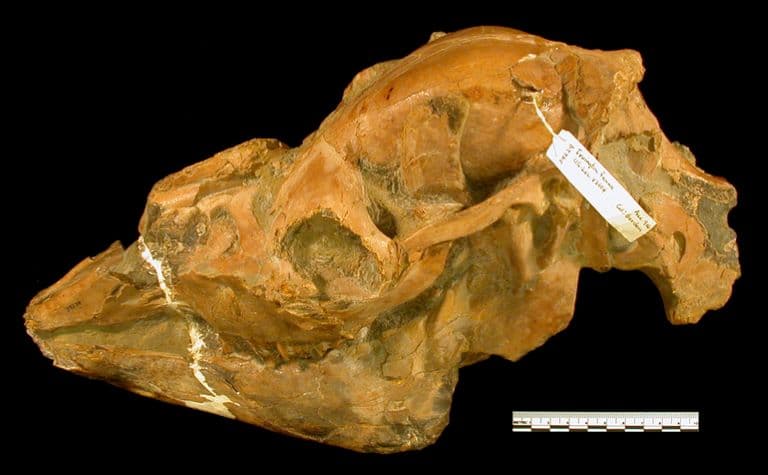Yesterday’s Camel Profile
Today, there are three species of camel: the Dromedary and two species of Bactrian, all now associated with deserts and Bedouin culture. Today, the camel family has a few other members, including the Llama, the Alpaca and the Vicuña, which is essentially just another Alpaca with a cooler name.
There are at least seven members of the Camelidae family today. But ‘yesterday’, there were huge camels all over America, and Yesterday’s Camel shows us that things were once very different in the family Camel.

Yesterday’s Camel Facts Overview
| Habitat: | Forests and shrublands, shrub-tundra |
| Location: | Western North America |
| Lifespan: | Unknown |
| Size: | 2.2m (7ft) tall |
| Weight: | Possibly more than 800kg (1760lb) |
| Colour: | Unknown |
| Diet: | Grasses and herbs |
| Predators: | Every large Pleistocene predator |
| Top Speed: | Probably very fast |
| No. of Species: | 1 |
| Conservation Status: | Extinct |
Perhaps surprisingly, Yesterday’s camel came from what is now North America, which is where animals such as camels and horses originated. From the fossil record, their taxonomy had been a matter of debate until very recently, when they were identified using collagen sequencing as resembling the classic Dromedary/Bactrian camels.
Its name means “Camel Face”, but you’d probably not want to call it that because these camels would have been exceedingly tough to hang out around the kinds of predators of the Pleistocene Americas.
While there used to be camels of all shapes and sizes roaming the Earth, we still don’t know much about them, and Yesterday’s camel is hesitant to give up all its secrets just yet.
Interesting Yesterday’s Camel Facts
1. People thought they were giant llamas
Until very recently, the argument of whether Camelops was a camel-like camel or a llama-like camel seemed far from being settled.
People who had wasted their entire lives studying camels were convinced that this animal was a giant llama. It was slender, lanky, and generally more llama-like than camel-like.
But the awesome thing about genetic studies is that it cuts through the fog of convergent evolution and shows us what’s really going on inside. And by around 2015, it became clear that these were in fact true camels.
But this doesn’t make Yesterday’s Camel any less unusual.

2. It was a true camel face
The word Camelops could very well have been lifted from the pages of a Spike Milligan poem, but someone very serious decided on this name for one of the numerous extinct genera of ancient camel.
It turns out, that much about camels is kind of whacky. Camelini, far from being a mall Sicilian village, is the name given to the tribe in which Camelops resides, and this happens to be also where the most recognisable spitters from the Camelidae family also sit.
This tribe also had some strange members. There were giraffe-like camels like Aepycamelus, 2.5-ton behemoths like the “bigfoot” Titanotylopus, and fat shaggy arctic camels like the High Arctic Camel Paracamelus.
All of these were true camels, as opposed to the wannabe camels like the alpacas and llamas, as was Camelops hesternus, which is one of up to nine identified species in this genus so far, and translates to “yesterday’s camel face”. 1
3. They must have been tough
If you’ve never been spat on by a camel, you’re missing out; they are very good at expressing their disgruntlement.
But it’s hard to imagine a well-placed wad of snot would have done much to deter the enemies of Yesterday’s camel, who would have had to put up with the likes of Sabre-toothed tigers, giant bears, lions, dire wolves and any number of other giant, snarling, predatory hulks of the time.
This camel was likely food for almost anything that ate meat, and as such would have had to compensate for this.
The prevalence of Camelops fossils suggests these were in high abundance across the continent, and this would have been one way to compensate for over-predation, but in terms of fighting back, it might be surprising to note the huge teeth in modern camels.
Camelops likely had all this and more, and with their extremely long legs, they were both fast and nasty kickers when they needed to be.
4. One hump or two?
Camels’ humps are a fat reserve and Bactrian camels evolved theirs from living in cold and dry arctic regions. As they migrated south, two humps evolved into one, and the Southernmost camelids in the Americas lost theirs altogether.
Whether or not Yesterday’s camel had a hump remains to be seen, since these large fatty deposits don’t survive into the fossil record.
The skeleton does show some elongation on the vertebrae on the back of its neck, suggesting there may have been support for a single hump, but until we find the cave paintings, we may never know for sure.
5. Early visitors made camel faces out of them
Not only were these animals a primary source of protein for humans as they made their way over the Americas, but they also provided some medium for cultural expression.
Sacrums from Camelops have been found in Mexico, carved into the shape of a dog’s head and are some of the earliest examples of physical prehistoric art, and is probably the only example of true art that has yet been found in Paleo-Indian levels in the New World. 2

6. They were perhaps present in some of the earliest barbecues
The Clovis people were some of the earliest human predators on the American continent. What little we know about them comes from stone tools and other archaeological remains, including those left by the animals they are.
Or, perhaps more accurately, found within those animal remains.
Around 13,000 to 10,000 years ago, countless species of large mammals began dropping dead. The climate was changing rapidly, and it’s thought that many of the species adapted to the chilly conditions of the Ice Age simply weren’t fit for the new, temperate environment.
For a long time, it’s been quietly ignored that this period also coincides with a massive uptick in the presence of humans. But it’s becoming increasingly difficult to ignore the correlation, and the consensus is slowly swinging towards humans as a significant contributor to the megafaunal extinction.
The bones of Yesterday’s camel, once one of the most common large mammals in what is now Western Canada, have been found with Clovis spear marks on them. Along with wild horses, they likely contributed significantly to the diet of the Palaeolithic human settlers of the time.
Yesterday’s Camel Fact-File Summary
Scientific Classification
| Kingdom: | Animalia |
| Phylum: | Chordata |
| Class: | Mammalia |
| Order: | Artyodactyla |
| Family: | Camelidae |
| Genus: | Camelops |
| Species: | hesternus |
Fact Sources & References
- “Camelops hesternus”, Prehistoric Fauna.
- Luis Aveleyra Arroyo de Anda (1965), “The Pleistocene Carved Bone from Tequixquiac, Mexico: A Reappraisal”, Cambridge University Press.
